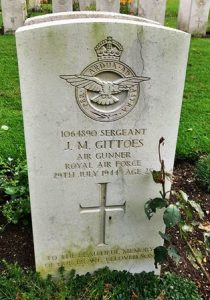Llyswen is a small village in the historic county of Breconshire, situated on the west bank of the river Wye on the junction of the A470 and A479 main roads. The village lies about eight miles north-east of the county town of Brecon. The parish church is dedicated to St. Gwendoline and contains the original war memorial to the men of the village who fell during the Great War. This memorial takes the form of a war memorial window and commemorates by name the seven local men who were killed, as well as commemorating those who served and returned home. A more recent memorial is situated at the junction of the A479 and the A470 main roads, which commemorates seven men who fell during the Great War and another man who was killed in World War Two. Oddly the names of the Great War fallen on the two memorials do not quite tally. I have taken the opportunity to add details of several men who are omitted from both memorials.
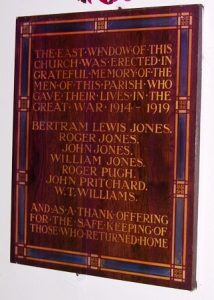
The Great War, 1914 – 1918
Stephen Henry Christy, DSO, MiD, Captain, 20th Hussars. Stephen was born at Highfield, in Bramhall, Cheshire on 27 April 1879, the son of Stephen Cristy, JP, and Blanche Christy (nee Chichester). His father was a hat and towel manufacturer in the family business, House of Christy. Stephen was educated at Harrow from 1893-1897, before entering Christ Church Oxford in 1898 and was commissioned from the 3rd Battalion, Royal Welsh Fusiliers (Militia) into the 20th Hussars on 20 December 1899. Stephen served as a Staff officer during the Anglo-Boer War of 1899-1902, gaining the Queen’s Medal with four clasps. He then served during the Sokoto-Burmi operations in North Nigeria in 1903, where he was awarded the Distinguished Service Order. Upon returning to Britain, Stephen married Violet Chapell-Hodge at Holy Trinity Church, Stone Street, London on 7 November 1905. By now his elder brother, Hugh Archibald Christy, had bought Llangoed Hall, in Llyswen. Stephen left the army in 1906 and was placed on the Army Reserve of Officers. He then moved to Plaish Hall, in Shropshire with his wife and became well-known in country circles, becoming Master of the South Shropshire Hounds. Sadly, his wife Violet died in November 1913, so at the outbreak of war, Stephen immediately volunteered for active service, re-joining the 20th Hussars and being given command of B Squadron. He was promoted captain on 14 August, then three days later embarked for France with the regiment aboard the SS Indore, as part of the 5th Cavalry Brigade, which upon disembarkation entrained for the Belgian frontier town of Mons with the BEF. On 23 August 1914 the Germans attacked the BEF positions around Mons in overwhelming numbers. The BEF was forced to withdraw southwards under extreme pressure over the coming days, putting up a stout rear-guard action at Le Cateau, before continuing its withdrawal south, crossing the banks of the river Marne, after a series of engagements, by 3 September. On the morning of 3 September 1914, whilst situated some five miles from Meaux, Stephen led B Squadron forward to support A Squadron as it continued its withdrawal under heavy fire. Stephen then led his men forwards to positions at a farm in Caissy, before heavy fire and an attack from German aircraft forced him to withdraw his men towards the Marne. Stephen was shot in the head and killed instantly, while also having his horse shot from under him. The 35-year-old was buried by a farmer on his farmland at Caissy. In March 1920 his grave was exhumed, and Stephen was re-interred in Perreuse Chateau Franco British National Cemetery, France. Stephen is not commemorated on the Llyswen war memorial.
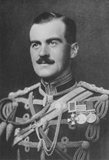
George Edward Eastmond, Sergeant, G/2663, The Buffs (East Kent Regiment). George was born on 1 September 1888, the son of William John Eastmond and Eliza Jane Eastmond (nee Budgen), of 1, Station Cuttings, Cheam, Surrey. His father worked as a railway platelayer, and the family moved around the country following his work over the coming years. George followed his father into the railway industry and by 1911 was working as a railway labourer. His father had by now died and the family were living in Little Bytham, Grantham. Soon afterwards, the family moved to Llangoed, Llyswen. George enlisted into 7th Battalion, The Buffs (East Kent Regiment) at Sittingbourne soon after the outbreak of war. The battalion had formed at Canterbury in September 1914, moving to Purfleet to join 55 Brigade, 18th (Eastern) Division. George came home to Llyswen on leave in December and on 26 December 1914 gave away his sister Lilian during her marriage to another soldier, Joseph Thomas Reed, at Llyswen Parish Church. He re-joined his unit at Purfleet soon afterwards. In April 1915 the Division moved to Colchester, then in May 1915 to Salisbury Plain. George landed with the 7th Buffs at Boulogne on 25 July 1915, and the entire division assembled in Flanders before moving into the Ypres Salient for trench initiation. In July 1916 the division moved south, to join the great Somme offensive and saw its first major action at the Battle of Bazentin, where it captured Trônes Wood, before taking part in the gruesome fighting for Delville Wood. In October the division took part in the Battle of the Ancre Heights, capturing Schwaben Redoubt, and helped capture Regina Trench. It then fought at the Battle of the Ancre, and during the subsequent Operations on the Ancre, before spending the winter on the Somme. In March 1917 the division followed the German Retreat to the Hindenburg Line, and in May took part in the Third Battle of the Scarpe, which was part of the Arras Offensive. July 1917 saw the Division at Ypres, where it took part in the Battle of Pilckem, and helped capture Westhoek before taking part in the Battle of Langemarck. The division remained at Ypres over the coming months, taking part in the First Battle of Passchendaele, followed by the Second Battle of Passchendaele, before wintering in the salient. In 1918 the Division was stationed south of the Somme and became hit there by the German Spring Offensive of 21 March 1918, suffering terrible casualties as the line was driven back over the coming days. The division remained on the Somme and on 8 August 1918 formed part of the force which attacked the German positions around Villers Bretonneux, south of the Somme Valley, during the Battle of Amiens. The division then took part in the great Allied offensive, which was launched on 21 August 1918 and began driving the Germans back towards the Hindenburg Line. George was killed in action on the second day of this great offensive, on 22 August 1918. The 29-year-old was originally buried on the battlefield, together with several other men, but in October 1919 their graves were exhumed and re-interred in Bapaume Post Military Cemetery, Albert, France. George is not commemorated on the Llyswen war memorial.
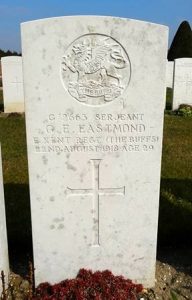
Ebenezer Evans, Private, 26172, Welsh Regiment. Ebenezer was born at Llyswen in 1879, the son of Thomas and Ann Evans. He was baptized in Llyswen Church on 20 April 1879. By 1881 the family had moved to Penrhiw Farm, Ystradfodwg, where Thomas worked as a farmer. The family then moved to Porth, where Ebenezer and his father gained work as coal hauliers. Ebenezer married Sarah Dorothy Benbow, a single mother of one, on 20 September 1910, and the couple set up home at 8, John Street, Porth, where two further children were born. He enlisted at Pontypridd into the 17th Battalion, Welsh Regiment during the spring of 1915. The battalion was raised in January 1915 as a Bantam Battalion, made up of men of below average height, and initially went to Porthcawl attached to the 43rd (Welsh) Division. During July 1915 the battalion moved to Prees Heath to join 119 Brigade, 40th (Bantam) Division and landed in France with the Division in June 1916. The Division moved to positions around Lillers before taking over the North Maroc Sector, near Loos, for trench initiation and once acclimatised was left to hold the sector itself over the coming months. The infantry battalions of the Division then began the usual routines of rotating for duty in the trenches: normally four days in the front line; four in support and four in reserve. Late in 1916 the Division moved south to the Somme, and fought at the Battle of the Ancre, before remaining in the sector over the winter. In March 1917 the Germans withdrew to their shortened line, called the Hindenburg Line, and the 40th Division was among the units which followed the withdrawal. On 24 August 1917 the 17th Welsh relieved the 18th Welsh in the Villers-Plouich sector, to begin a routine tour in the trenches. By now Ebenezer had taken ill and been evacuated to a nearby Casualty Clearing Station. He died there of uraemia on 28 August 1917. The 38-year-old was buried in Rocquigny-Equancourt Road British Cemetery, Manancourt, France. Ebenezer is not commemorated on the Llyswen war memorial.
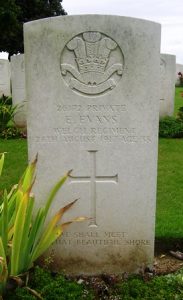
Edward Hatcher, Private, 1321, Welsh Guards. Edward was born in 1888, the eldest of three sons of Edward Hatcher and Annie Hatcher (nee Carter), of Appleshaw Street, Appleshaw, Hampshire. He had served as a Policeman at Brecon and Llanwrtyd Wells prior to the war and enlisted at Brecon into the 1st Battalion, Welsh Guards. He married Elizabeth Mary Williams of Upper House, Llyswen whilst home on leave on 5 August 1916. He joined the battalion, which was attached to the 3rd Guards Brigade, Guards Division, in France during the summer of 1916, in time to take part in the Battle of the Somme. On the night of 8 September 1916, the Welsh Guards moved passed Cuinchy through Guillemont towards the front line, in preparation to take over the line on the following morning prior to the next phase of the offensive towards Leuze Wood. The situation was confusing, and the Guardsmen struggled to get to their proper positions, encountering strong German opposition during the morning. Edward was killed in action during heavy fighting on 10 September 1916. He was 28 years old and was buried in London Cemetery & Extension, Longueval, France. His brother, John Philip Hatcher, was also killed on the Somme, on 20 December 1916, whilst their other brother, Willie, had sadly died in 1913. Edward is not commemorated on the Llyswen war memorial.
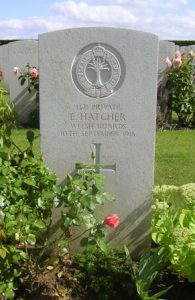
Bertram Ivor Lewis Jones, Second Lieutenant, South Wales Borderers. Bertram was born in April 1897, the son of Lewis William Hugh Jones and Dora Annie Jones (nee Bellis), of Great House, Llyswen. He was educated at Trinity College, Glenalmond, and was a member of the O.T.C. there when war erupted. Bertram applied for a commission on the outbreak of the war, and was commissioned Second Lieutenant into the 3rd Battalion, South Wales Borderers on 15 August 1914. Bertram joined the battalion at Brecon but following the return to England of the 2nd Battalion, South Wales Borderers on 12 January 1915, was posted to the newly arrived battalion, which had just taken part in a unique action against the Germans in Tsingtao, China. The battalion had entrained at Plymouth for Rugby to join 87 Brigade, 29th Division. On 17 March 1915 the battalion sailed from Avonmouth with the Division, arriving at Alexandria on 29 March, before moving to Mudros. On 25 April 1915 the Division landed at Cape Helles, Gallipoli, as part of the original landing force which had been despatched to try and seize the Dardanelles Straits and force Turkey out of the war. The invasion forces failed to break the Turkish defences and the campaign became bogged down into static trench warfare. On 22 June 1915, Bertram led a platoon out as an advanced party, in an attempt to recapture a section of Turkey Trench. He was killed by a Turkish grenade as he climbed out of the parapet of his trench and was killed instantly. His body was recovered by one of his men and the 18-year-old was buried with about three other officers and 40 men of the battalion in Geoghegan’s Bluff, about half-a-mile behind the trenches. The cemetery was later named Twelve Tree Copse Cemetery, and Bertram still lies there today.
John Jones, Private, 22536, South Wales Borderers. John was born in 1880, the son of David Jones, and Louisa Jones (nee Newman), of The Post Office, Llyswen. John worked as a rural postman in the area prior to the war and was a member of the Brecknockshire Battalion, South Wales Borderers. John enlisted at Newport into the 11th Battalion, South Wales Borderers soon after the outbreak of war. The battalion was at Colwyn Bay attached to the 43rd (Welsh) Division. The Division trained in North Wales before moving to Winchester in the summer of 1915, where the formation became renumbered 115 Brigade, 38th (Welsh) Division. The Division began moving to France on 2 December 1915 and moved to the Nursery Sector near Fleurbaix for trench initiation alongside the Guards Division. The Division then held a sector of the line near Cuinchy before marching south to the Somme sector in June 1916 to take part in the assault on Mametz Wood. The first attack on the wood was launched on a two-battalion front on 7 July, but failed, and the Divisional Commander, Sir Ivor Philipps, was replaced before the Division attacked again on a two Brigade front on 10 July 1916. After two days of ferocious hand-to-hand fighting, the wood was cleared up to its northern edge, before the battered Division was relieved. It then took over a section of the front at Hébuterne before moving to the Ypres Salient and taking over the Canal Bank sector at Boesinghe. The infantry battalions of the Division then began carrying out the normal pattern of rotation in the trenches, four days in the front, four in support and four in reserve, whilst also working on trench improvement, digging new trenches, and carrying out regular patrols and trench raids. On 31 July 1917 the Division launched its famous assault on the Pilckem Ridge, capturing Iron Cross and reaching its objective of the Steenbeek. John was killed in action during the terrible fighting that day. The 35-year-old has no known grave and is commemorated on the Ypres (Menin Gate) Memorial, Belgium.
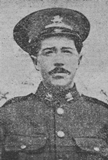
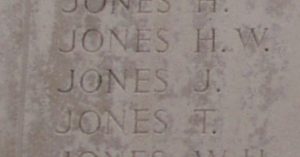
Raymond Jones, Private, 22401, South Wales Borderers. Raymond was born in 1896, the son of Enoch Jones and Annie Jones (nee Rouse), of Wernycwm, near Llyswen. He was working for Tom and Mary Brewin at Modrydd Farm, Libanus, Brecon by 1911, by which time his parents had moved to Church House, Boughrood. Raymond enlisted at Talgarth into the 11th Battalion, South Wales Borderers soon after the outbreak of war. The battalion was at Colwyn Bay attached to the 43rd (Welsh) Division. The Division trained in North Wales before moving to Winchester in the summer of 1915, where the formation became renumbered 115 Brigade, 38th (Welsh) Division. The Division began moving to France on 2 December 1915 and moved to the Nursery Sector near Fleurbaix for trench initiation alongside the Guards Division. The Division then held a sector of the line near Cuinchy before marching south to the Somme sector in June 1916 to take part in the assault on Mametz Wood. The first attack on the wood was launched on a two-battalion front on 7 July, but failed, and the Divisional Commander, Sir Ivor Philipps, was replaced before the Division attacked again on a two Brigade front on 10 July 1916. After two days of ferocious hand-to-hand fighting, the wood was cleared up to its northern edge, before the battered Division was relieved. It then took over a section of the front at Hébuterne before moving to the Ypres Salient and taking over the Canal Bank sector at Boesinghe. The infantry battalions of the Division then began carrying out the normal pattern of rotation in the trenches, four days in the front, four in support and four in reserve, whilst also working on trench improvement, digging new trenches, and carrying out regular patrols and trench raids. Raymond took ill during the spring of 1917 and died of disease on 9 April 1917. The 21-year-old was buried in Mendinghem Military Cemetery, Belgium. Raymond is not commemorated on the Llyswen war memorial but is commemorated on a plaque within Boughrood Church. He had an illegitimate child with Gertie Bevan of Talgarth.
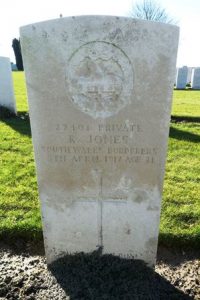
Roger Thomas Jones, Private, 2212, South Wales Borderers. Roger was born on 22 February 1896, the son of William Gunter Jones and Eliza Maria Jones (nee Ricketts), of Lower House, Llyswen. He was educated at Hampton Grammar School, and in March 1914 became a clerk at Hay Branch of the National Provincial Bank. Roger enlisted at Brecon into the Brecknockshire Battalion, South Wales Borderers soon after the outbreak of war. The battalion was attached to the Welsh Division and moved to Pembroke Dock upon mobilisation. It was then withdrawn from the Division and on 29 October 1914 sailed from Southampton for Bombay, where the battalion transhipped and sailed for Aden, arriving on 16 December 1914. The climate in Aden was fearsome, with scorching heat during the day, and with little to do, the men spent much of their free time playing football. By June 1915 the Turks had become overconfident due to the lack of any incursions by the British into Yemen and moved forward to reoccupy fortifications at Sheikh Saad. They then began to shell the island of Perim, so the Allied troops in Aden were mobilised into the Aden Movable Company and ordered to prepare to join with local troops. 400 men of the Brecknocks were allocated to the column, the remainder stayed in Aden. A small artillery column was built up to join it and on 3 July the force moved out to Sheikh Othman. Many men collapsed on the march, which was carried out during the full heat of the day, but by 7.30 pm the column had completed its six-mile advance. Thirteen men died of heatstroke during the following day, 4 July 1915, during an even longer march. Roger had also collapsed with heatstroke during this folly and died six days later, on 10 July 1915. The 19-year-old was buried in Maala Cemetery, Yemen.
William Jones, Private, M/335245, Army Service Corps. William was born in 1882, the son of William Jones and Mary Ann Jones (nee Davies), of Lay Cottage, Llyswen. He had left home by 1911 and was working in Norfolk as a chauffeur for Mr Bertram Philip Paris Barwell, a businessman and wine merchant, who had recently married Jessie Gertrude Rich, of Brecon. William married Edith Mary Calver, a domestic servant, at Norwich on 7 March 1912 and the couple later set up home at 19a, Glodwick Road, Oldham, with their only child, Dorothy. William enlisted at Oldham into the Army Service Corps on 12 December 1915 and after qualifying as a Ford Motor Lorry Driver, embarked at Plymouth for the Middle East on 23 July 1917, disembarking at Basra almost two months later to join Dunsterforce. He was then posted to the 818th Motor Transport Company, Army Service Corps. He served in the arid conditions here for over a year before falling ill and was hospitalized at Hamadan on 24 August 1918, initially with conjunctivitis. His health deteriorated and William died at Hamadan of enteric fever on 26 September 1918. The 36-year-old was buried in Tehran War Cemetery, in what is now Iran. His widow, Jessie, returned to Norfolk and remarried. She died in 1977.
William James Jones, Private, 33548, South Wales Borderers. William was born in 1886, the son of William James Jones and Esther Jones (nee Prosser), of Central Stores, Llyswen. He enlisted at Bridgend into the 22nd Battalion, Welsh Regiment and was posted to Kinmel Park, where he was transferred to the 13th Battalion, South Wales Borderers. The battalion was a reserve unit, utilized for training new recruits. William had not been at Kinmel Park long when he took ill and was admitted into the military hospital there, suffering from acute bronchitis. He died in hospital just days later, on 10 April 1916. The 29-year-old was buried with full military honours in Abergele Churchyard. Sadly, his brothers were on their way to collect his remains to bring him home for burial at Llyswen, but they arrived too late.
Charles James Lewis, Private, 1775, South Wales Borderers. Charles was born on 17 July 1896, the son of Joseph Lewis and Mary Ann Lewis (nee Morris), of The Old Post Office, Llyswen. By 1911 Charles had left home and was working as a farm servant for Christopher and Catherine John at Ffrwd Uchaf Farm, Cefn Coed. Charles enlisted at Hay into the Brecknockshire Battalion, South Wales Borderers soon after the outbreak of war. The battalion was attached to the Welsh Division and moved to Pembroke Dock upon mobilisation. It was then withdrawn from the Division and on 29 October 1914 sailed from Southampton for Bombay, where the battalion transhipped and sailed for Aden, arriving on 16 December 1914. The climate in Aden was fearsome, with scorching heat during the day, and with little to do, the men spent much of their free time playing football. By June 1915 the Turks had become overconfident due to the lack of any incursions by the British into Yemen and moved forward to reoccupy fortifications at Sheikh Saad. They then began to shell the island of Perim, so the Allied troops in Aden were mobilised into the Aden Movable Company and ordered to prepare to join with local troops. 400 men of the Brecknocks were allocated to the column, the remainder stayed in Aden. A small artillery column was built up to join it and on 3 July the force moved out to Sheikh Othman. Many men collapsed on the march, which was carried out during the full heat of the day, but by 7.30 pm the column had completed its six-mile advance. Charles was among thirteen men who died of heatstroke during the following day, 4 July 1915, during an even longer march. The 19-year-old has no known grave and is commemorated on the Heliopolis (Aden) Memorial, Egypt. His brother, Joseph Thomas Lewis, had been killed at Gallipoli on 25 April 1915. The brothers had met briefly in Aden, when the 2nd SWB were on their way to England from China. Neither of the brothers are commemorated at Llyswen, but at Hay-on-Wye.
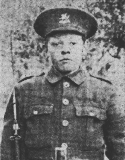
Joseph Thomas Lewis, Private, 10640, South Wales Borderers. Joseph, known as Thomas, was born in 1893, the son of Joseph Lewis and Mary Ann Lewis (nee Morris), of The Old Post Office, Llyswen. He left home as a young man and by 1911 was at Brecon Barracks serving with the South Wales Borderers. Thomas then embarked for China with the 2nd Battalion, South Wales Borderers prior to the war. The battalion was in Tientsin at the outbreak of war and took part in a famous operation with the Japanese against the German held port of Tsingtao on 23 September. On 4 December the battalion embarked at Hong Kong and landed at Plymouth on 12 January 1915, entraining for Rugby to join 87 Brigade, 29th Division. On 17 March 1915 the battalion sailed from Avonmouth with the Division, arriving at Alexandria on 29 March, before moving to Mudros. On 25 April 1915 the Division landed at Cape Helles, Gallipoli, as part of the original landing force which had been despatched to try and seize the Dardanelles Straits and force Turkey out of the war. Thomas was killed in action during the landing of the 2nd SWB on 25 April 1915. The 23-year-old has no known grave and is commemorated on the Helles Memorial, Gallipoli. His brother, Charles James Lewis, died at Aden on 4 July 1915. The brothers had met briefly in Aden, when the 2nd SWB were on their way to England from China. Neither of the brothers are commemorated at Llyswen, but at Hay-on-Wye.
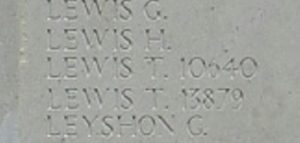
William George Morris, Private, 200557, South Wales Borderers. William was born in 1896, the son of Joseph Morris and Ada Morris (nee Beavan), of Walnut Cottage, Winforton, Eardisley, Hereford. By 1911 he was living at Y Dderw, Llyswen, where he worked as a gardener. William left Llyswen and enlisted at Brecon into the Brecknockshire Battalion, South Wales Borderers on 21 August 1914. He was posted to the newly formed 2nd Brecknockshire Battalion, South Wales Borderers. The battalion left Brecon for Dale, in Pembrokeshire in April 1915 to join the Milford Haven garrison, then at the end of 1915 moved to Bedford to join the 68th (2nd Welsh) Division. In November 1916 the battalion was absorbed by the 2/7th Battalion, Royal Welsh Fusiliers at Wrentham, near South Wold, and moved to Benacre Camp, Wrentham. Soon afterwards William’s health began to fail, and he was hospitalised at Thetford, suffering from pyrexia. He was discharged from hospital and returned home in December on leave, but contracted pneumonia. William was not well enough to return to Norfolk until 3 February 1917, but by then he had been diagnosed as having contracted tuberculosis, so he was discharged from the army as medically unfit on 4 April 1917. William returned home to his parents at Eardisley, where he died of phthisis on 27 April 1918, aged 22. William is not commemorated by the CWGC, nor is he commemorated on the Llyswen war memorial.
John Pritchard, Private, 57829, Machine Gun Corps. John was born at Onibury, Shropshire in 1896, the son of Charles Pritchard and Edith Pritchard (nee Burgoyne). The family had moved to Alvechurch, Worcester by 1911, then prior to the war had moved to Stockley Cottage, Erwood. John enlisted at Brecon into the South Lancashire Regiment during the spring of 1915. He probably served in France with the 1st Battalion, South Lancashire Regiment, before being transferred to the 38th Battalion, Machine Gun Corps following its formation from the merging of the four Machine-Gun Companies of the 38th (Welsh) Division in February 1918. The Division was in the Sailly-sur-la-Lys sector, then moved to positions north of Albert, at Bouzincourt Ridge, at the end of March 1918, relieving the battered 2nd and 47th Divisions. It held this sector, again carrying out minor operations and trench raids, over the coming months, before taking part in the great offensive of 21 August 1918, and began its advance towards the Hindenburg Line. The 38th Battalion, Machine Gun Corps was in position at Forceville on the evening prior to the assault, then crossed the river Ancre on the morning of 21 August 1918 in support of the assaulting infantry battalions. John was killed during the day when a German aircraft dropped two bombs onto the battalions transport lines. The 22-year-old was buried in Forceville Communal Cemetery and Extension, France.
Roger James Pugh, Private, 55073, Royal Welsh Fusiliers. Roger was born in 1892, the son of John Pugh and Winifred Mary Pugh of Oak Cottage, Llyswen. He worked as a domestic gardener prior to the war. Roger enlisted at Brecon into the Monmouthshire Regiment, but upon being drafted to France in the summer of 1916 was transferred to the 1st Battalion, Royal Welsh Fusiliers, which was on the Somme, attached to 22 Brigade, 7th Division. The Division had taken part in the opening assault of the Somme offensive on 1 July 1916, advancing from positions near Bois Francais, near Fricourt, and capturing the village of Mametz, one of the few successes of 1 July 1916. The battalion then took part in further attacks to push forwards, to the south of Mametz Wood, and upon being relieved, witnessed the troops of the 38th (Welsh) Division moving forward to launch its assault on Mametz Wood. On 14 July, with the wood taken, the 7th Division moved back into the line, with orders to capture Bazentin-le-Petit, before taking part in the terrible attacks on High Wood over the coming days. On 22 July the 1st RWF was relieved, moving back into reserve to rest and rebuild at La Chaussee. By 12 August the battalion had moved forwards to Dernancourt, and on 26 August marched further forward, to take part in the Divisions assault on Ginchy. The Division saw heavy fighting over the coming days, before the 1st RWF had another short break, but on 1 September the battalion received orders to push forwards again to launch a fresh assault on Ginchy from Montauban Alley. On 3 September 1916 the 1st RWF launched its assault, but suffered severe casualties, with over 200 officers and men killed, wounded or missing. Roger was wounded during the latter stages of the Somme offensive and was evacuated home for treatment. He came home to Llyswen on furlough in February 1917 before returning to France to re-join his battalion. By the time he returned to France, the Germans were in the process of withdrawing to the Hindenburg Line, to shorten the front, enabling them to release more troops. The 7th Division followed the withdrawal, before reaching positions facing the Hindenburg Line near Bullecourt. The first attacks on Bullecourt began on 11 April 1917 and raged over the coming weeks. Roger was killed in action during an assault by the 1st RWF on 14 May 1917. The 23-year-old has no known grave and is commemorated on the Arras Memorial, France.
Walter John Williams, Rifleman, 3135, Monmouthshire Regiment. Walter was born in 1878, the son of John Williams and Mary Ann Williams (nee Price), of New Gardens, Llangoed, Llyswen. He married Fanny Elizabeth Cartwright at Hay in 1899 and the couple initially lived at Lower Blakemore, where Walter worked as an agricultural labourer. By 1911 the couple were residing at 3, Chapel Row, Pantywaen, Dowlais, where Walter had gained work as a coal mine repairer, but soon afterwards he began work for the Newport Corporation Transport and the couple moved to Fochriw. Walter enlisted at Rhymney into the Monmouthshire Regiment soon after the outbreak of war. He embarked for France on 29 April 1915, joining the 1st Battalion, Monmouthshire Regiment, which was in the Ypres Salient, attached to 84 Brigade, 28th Division and was holding the line in the Polygon Wood sector. On 22 April, just to the north, the Germans launched the first gas attack of the war upon French Colonial troops at Gravenstafel, heralding the opening of the Second Battle of Ypres. The fighting remained to the north of Polygon Wood until 3 May, when the Germans widened their attacks and the Polygon Wood sector was evacuated by the 28th Division, which fell back on the G.H.Q. line at Potijze. Over the coming days their new positions were shelled mercilessly, then on 8 May the Germans attacked, and the division was caught up in a ferocious fight. Walter was killed in action that day, 8 May 1915. The 37-year-old has no known grave and is commemorated on the Ypres (Menin Gate) Memorial, Belgium. Walter is not commemorated on the Llyswen war memorial.
World War Two, 1939 – 1945
Jenkin Morgan Gittoes, Sergeant, 1064890, Royal Air Force Volunteer Reserve. Jenkin was born in 1919, the son of Vincent Fred Gittoes and Blodwen Tydvil Gittoes (nee Morgan), of Pistyll, Boughrood. He enlisted into the Royal Air Force Volunteer Reserve soon after the outbreak of war and after completing his training as an Air Gunner, was posted to 57 Squadron, Royal Air Force. The squadron had been in France with the BEF at the outbreak of war and upon returning to Britain moved to RAF Feltwell in November 1940 to re-equip with the Vickers Wellington. In September 1942 the squadron moved to RAF Scampton and converted to Avro Lancaster’s, then moved with its Lancaster’s to RAF East Kirkby in August 1943. Jenkin married Doreen Frances Jones at Llyswen whilst on leave in the summer of 1943. On the night of 28 July 1944, Jenkin took off from RAF East Kirkby aboard an Avro Lancaster I, Serial ME864 as part of a large bomber force despatched to hit targets in Stuttgart. On the morning of 29 July 1944 his Lancaster was intercepted by a German night fighter and was shot down over Eutingen, north-east Pforzheim, with the loss of three of her crew of seven men. 25-year-old Jenkin was killed in the crash and was buried with his two comrades in Eutingen Civilian Cemetery, in Germany. In July 1948 their graves were exhumed, and the three men were re-interred in Durnbach War Cemetery, Germany.
